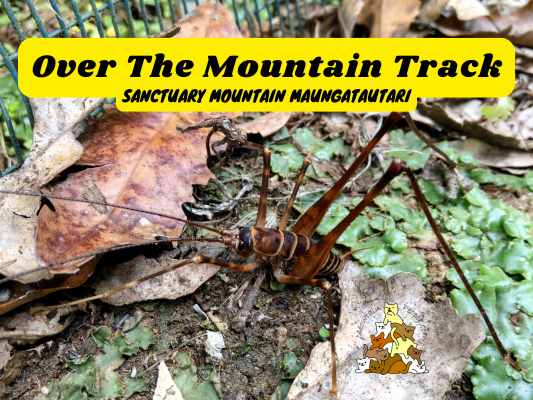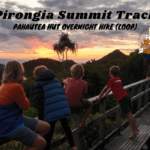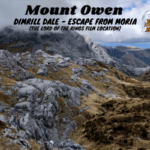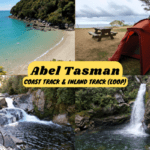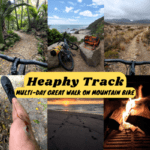Sanctuary Mountain in Waikato region is a vision turned reality to protect the native plants and animals living on Maungatautari. The precious environment of Maungatautari is now an eco-sanctuary protected by the largest pest-proof fence in New Zealand. Sanctuary Mountain Maungatautari offers various free, ticketed, and guided walks and tours for all ages, where you can experience New Zealand forest the way it used to be (before the mass eradication of native wildlife and plants by introduced predators and invasive pests).
While there is no cost associated with some of the trails, a donation to Sanctuary Mountain helps to cover the $5000/day it costs to keep the sanctuary going.
Sanctuary Mountain Maungatautari Walking & Hiking Trails
Northern Enclosure (Free)
The Northern Enclosure of Sanctuary Mountain Maungatautari is a loop track (around 1.5km) accessible to the public. It’s a good shaded spot for a quiet walk in the forest when you’re in the area. I used to bring the local kids here when I was an au pair for a family living nearby. There is a 1.5km unshaded and steep walk on a public road and a track through private farmland from the car park to the trail entrance (as pictured).
Southern Enclosure (Day / Annual Pass; Self / Guided)
Maungatautari Southern Enclosure is the highlight of Sanctuary Mountain, where you get the full sanctuary experience. The visitor center is located here, where you can purchase the day pass for self-guided walk, or to check-in for a scheduled guided tour (can be booked online). A self-guided day pass can be purchased for $30. As I was living not too far away and wanted to visit more frequently, I purchased the annual pass during new year sale for $45 ($100 for normal price).
The abundant birdlife and lush forest are my favorite indulgence on the many short, interconnected trails in the Southern Enclosure.
One of the most popular superstars in Maungatautari are the kākā. Kākā is a large native species of parrot in New Zealand. Thanks to conservation efforts such as the activities by Sanctuary Mountain community, these at-risk, endemic species of kākā population are on the path of recovery.
My favorite spot to watch kākā is at ‘The Clearing’ near the watchtower. Just sit quietly on the wooden bench and wait for a mob of kākā dropping by to feed / drink at the birdfeeder station.
Tautari Wetland: Meet The Living Fossils (Guided)
Located next to the Southern Enclosure, the Tautari Wetland is the sanctuary of two of New Zealand’s most ancient and endangered species:
- Tuatara (living dinosaurs): The largest reptile in New Zealand. Tuatara are the only survivors of an order of reptiles that thrived in the age of the dinosaurs.
- Takahē (legendary comebacks): Not once, but twice believed to be lost forever, takahē made an epic return 50 years after extinction! These critically endangered flightless birds helped shape the present and future of conservation in New Zealand.
Over The Mountain Tracks: Wairere Traverse VS Maungatautari Mountain Track (Free; Dayhike)
There are two track options to hike Over The Mountain on Maungatautari, both tracks start and end next to the Northern and Southern enclosures. There is no public transport at both ends.
Wairere Traverse Walking Track: Newly built, well formed walking track. Takes around 4 hours one-way.
Maungatautari Mountain Tramping Track: This is a more rugged track consisting of Te Raki Track and Te Tonga Track. This historic route goes over Maungatautari Summit and Pukeatua Peak. Takes around 6 hours one-way.
If you’re super lucky and sharp-eyed, you might encounter one of the rare kākāpō that were relocated to Sanctuary Mountain, one of the first populations that were reintroduced back to the mainland.
The following walkthrough will guide you through Maungatautari Mountain Tramping Track.
Over The Mountain (Maungatautari Mountain Track) - North To South
Te Raki Tramping Track
9.17am: A friend dropped me off at Hicks Rd road end, where the entrance through farmland to the Northern Enclosure starts.
(+8)9.25am: Arrived at the fenced Sanctuary Mountain. Follow the sign towards the Northern Enclosure entry.
(+2)9.27am: You’ll first arrive at the Northern Enclosure entrance. Walk past it and follow the sign to Over The Mountain Track.
(+1)9.28am: This is the entrance to Over The Mountain Track. Make sure to follow the biosecurity procedures when entering the fenced sanctuary.
A lizard on the fence. A rare find outside of the sanctuary.
(+3)9.31am: Here is the junction to both tracks of Over The Mountain. Turn left to Te Raki Track for Maungatautari Mountain Track.
(+12)9.43am
Compared to the Wairere Traverse, Te Raki and Te Tonga Tracks are less-formed, which suit hikers who want a more natural experience.
(+34)10.17am: Mostly uphill to the summit, then gradually down-up-down-up-down through another couple peaks.
(+11)10.28am
(+7)10.35am: Reached the summit of Maungatautari (797m). Not much view from here as it’s surrounded by trees. There’s some sort of solar-powered research / relay device on the summit.
Te Tonga Tramping Track
(+1)10.36am: From the summit, the trailhead to Te Tonga Track was a little concealed by the bush, but you’ll find it if you look for it.
(+10)10.46am: Te Tonga Track was even less-formed than Te Raki Track. It’s still trackable for experienced hikers but a hiking app such as Outdoor Active is essential to make sure you’re still on the right track. The perks of it being so wild is that I was surrounded by songs of birds, and delighted by the appearances of native birds such as fantails, saddlebacks and robins.
(+15)11.01am: A tree in a tree.
(+61)12.02pm
(+3)12.05pm: Arrived at Pukeatua Peak (753m). There’s a kākāpō tracker setup here.
(+20)12.25pm
(+4)12.29pm
(+3)12.32pm: Reached the ‘Rocky Outcrop’. Which has another kākāpō tracking post.
(+8)12.40pm: It’s downhill from here.
(+35)1.15pm: Te Tonga Track ends and joins Wairere Traverse Track to southern exit.
(+1)1.16pm: The well-formed Wairere Traverse Walking Track.
(+29)1.45pm: Exiting the southern gate to complete the Over The Mountain hike.
Prior to arriving at the exit, I encountered one of New Zealand’s most iconic insects: The Wētā! These endangered, alien-like endemic invertebrates are identifiable with their big bodies, spiny legs, and curved tusks. There are five broad groups of wētā: tree wētā, ground wētā, cave wētā. giant wētā and tusked wētā. This one is a cave wētā.
While waiting for my friend to pick me up, I entered the Southern Enclosure with my annual pass and watched a group of kākā at ‘The Clearings’.
Have this guide helped you? Tag @meowtainpeople in your hiking stories & posts!
*Captain Planet passing by* Remember, please take care of our environment, and please don’t destroy the Nature. Leave no trash behind and take back only photos and memories (and also some trash if you can). Walk on the designated path and stay in the middle as much as you can, so that the exposed soil doesn’t spread/corrode further. BE ONE WITH NATURE *flies away*
Affiliate Links to support this site:
Yay for transparency!: The links above are affiliate links, and at no additional cost to you, I earn a commission if you make a booking/purchase after clicking the links. I recommend only products and companies I use. Your support helps me keep the site going 🙂
Want to do the same affiliate marketing with your site? Use this AccessTrade platform link to receive RM5 reward.

